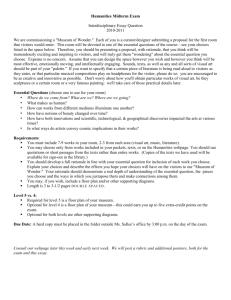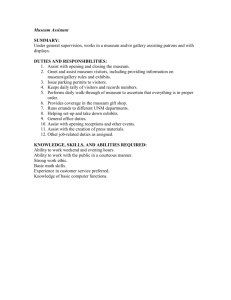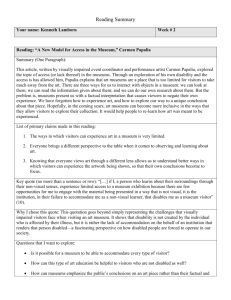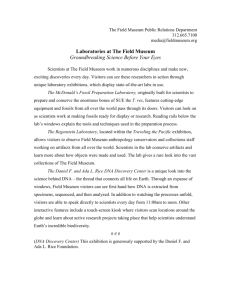Understanding how art museum visitors positively
advertisement
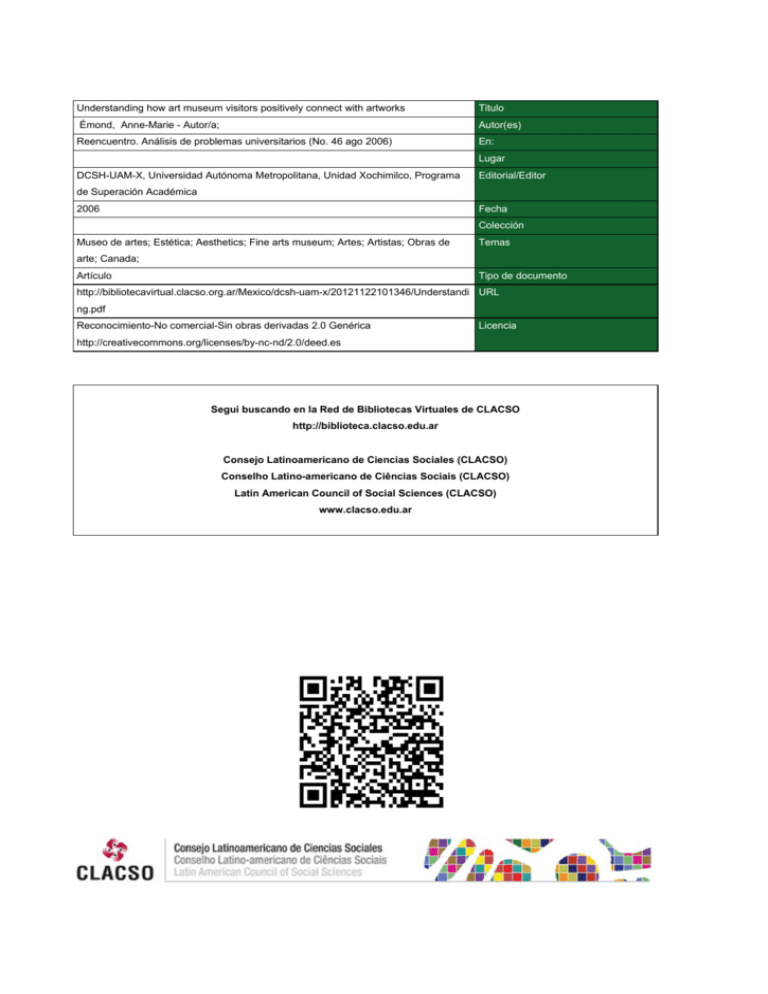
Understanding how art museum visitors positively connect with artworks Titulo Émond, Anne-Marie - Autor/a; Autor(es) Reencuentro. Análisis de problemas universitarios (No. 46 ago 2006) En: Lugar DCSH-UAM-X, Universidad Autónoma Metropolitana, Unidad Xochimilco, Programa Editorial/Editor de Superación Académica 2006 Fecha Colección Museo de artes; Estética; Aesthetics; Fine arts museum; Artes; Artistas; Obras de Temas arte; Canada; Artículo Tipo de documento http://bibliotecavirtual.clacso.org.ar/Mexico/dcsh-uam-x/20121122101346/Understandi URL ng.pdf Reconocimiento-No comercial-Sin obras derivadas 2.0 Genérica Licencia http://creativecommons.org/licenses/by-nc-nd/2.0/deed.es Segui buscando en la Red de Bibliotecas Virtuales de CLACSO http://biblioteca.clacso.edu.ar Consejo Latinoamericano de Ciencias Sociales (CLACSO) Conselho Latino-americano de Ciências Sociais (CLACSO) Latin American Council of Social Sciences (CLACSO) www.clacso.edu.ar Understanding how art museum visitors positively connect with artworks Anne-Marie Émond Facultad de Ciencias de la Educación, Universidad de Montréal, Canadá. Abstract This paper deals with the concept of consonance as it applies to the aesthetic experience of adults who visit a Fine Arts museum. Generally, when describing a visitor’s reaction to art, we do not talk in terms of conflict or harmony, but adopt the expression ‘aesthetic experience’. Much research has been conducted to describe aesthetic experience, for example, the research undertaken by Csikszentmihalyi and Robinson, 1990; Guillot, 2001; Housen, 1983). We are aware of the complexity of the term and the scope of its meaning in philosophy. Keywords: Fine Arts museum Aesthetic Resumen Este documento trata sobre la experiencia que viven los adultos que visitan un museo de Bellas artes. En general, cuando se describe la reacción del visitante ante el arte, no hablamos en términos de conflicto o armonía, pero adoptamos la expresión de “experiencia estética”. Muchas investigaciones se han dirigido a describir la experiencia estética, por ejemplo, la investigación desarrollada por Csikszentmihalyi y Robinson (1990); Guillot (2001); Housen, 1983. Estamos conscientes de la complejidad del término y la amplitud de su significado en filosofía. Palabras clave: Museo de artes Estética Those of us who work in art museums are concerned about the accessibility of art. We want to provide museum visitors with rich, purposeful experiences. We need to research the experiences of visitors in order to create the necessary tools that will enable them to make their own connections with the works on display. In this study, we are particularly concerned with the receptivity of visitors to artworks and to the possibility of their entering into a dialogue with artworks. We want to understand how we can help visitors feel confident about both their own interpretations and those of others. How can we help them take the time to look at art and to be in touch with their feelings? How can we encourage visitors to pursue their investigation of an artwork even if they feel dispassionate about it? Is it possible to find a way to trigger “visual curiosity”? Art educators would like to foster an environment in which visitors do not feel that they have to be art experts to voice their own interpretation of artworks. We believe that it is important for art educators to understand the experiences of visitors in order to develop ways of empowering them with respect to their own reactions to art. What happens to visitors whose definition of art does not include what they are exploring in the art museum? After their initial reaction, what do they make of what they see? What questions go through their mind? Do they decide to either reject or accept this new definition of art, or do they walk away, frustrated by their encounter with a work of art that they find difficult to comprehend? How do viewers close the gap between their expectations and the artworks they encounter? To understand further what happens between the visitor and the art object, we need more research. One of the art educator’s most frustrating problems is to not really know what works. What makes a particular visitor explore a work of art longer than another, and struggle to either reject or accept it? This paper deals with the concept of consonance as it applies to the aesthetic experience of adults who visit a Fine Arts museum. Generally, when describing a visitor’s reaction to art, we do not talk in terms of conflict or harmony, but adopt the expression ‘aesthetic experience’. Much research has been conducted to describe aesthetic experience, for example, the research undertaken by Csikszentmihalyi and Robinson, 1990; Guillot, 2001; Housen, 1983). We are aware of the complexity of the term and the scope of its meaning in philosophy. Traditionally, we view aesthetic experience as an experience that touches on qualities of the sublime; we are not working within this usual definition of aesthetic experience, because we are not focussing on the quality of the visitor’s aesthetic experience. Rather, we are interested in what actually happens to viewers during an encounter with aesthetic objects. We want to understand what are viewers’ aesthetic practices: what are their thoughts, how do they deal with moments of harmony or conflict. By aesthetic responses, we refer to all the verbal comments made 10n.........................................Agosto 2006 by viewers during their museum visit. We are studying the cognitive aspect of their aesthetic response. In a previous research (A. Weltzl-Fairchild, C. Dufresne-Tassé, L. Dubé, 1997), cognitive dissonance (conflict) was the component of the aesthetic response that researchers investigated, as this was a phenomenon that was not often researched. It proved to be a useful concept to understand the variations in reaction that viewers have when looking at artworks. In this study, we felt that it was time to look at the more commonly heard expressions of pleasure so we will be investigating the cognitive consonance (harmony) as a component of the aesthetic response. Paradigm of coherence, cognitive dissonance and consonance The theory of cognitive dissonance as articulated by L. Festinger, rested on the underlying assumption that human beings have a psychological need to have cognitive structures that are consistent and coherent (Festinger, 1957). The paradigm of cognitive consistency is: “...there exists a preferred state of the individual’s cognitive universe in which the relations between cognitions are maintained in a way that confers optimum coherence” (Beauvois and Joule 1996, p.ix). Cognitive consonance therefore means that a person’s cognitive schemas are in harmony with new data or information. The terms used to denote this paradigm can be “coherence”, “symmetry”, “consistency”, “congruence” or “consonance” depending on the writer. Festinger (1957) used the term consonance to explain the preferred state of human beings as opposed to the term cognitive dissonance, which indicates a lack of coherence. This is the term we shall use in this paper. According to Beauvois & Joule, the theory of consonance/dissonance implies three basic tenets: there needs to be a concept of cognition and two others, implication and incompatibility. Cognition is “...any knowledge, opinion, or belief about the environment, about oneself or about one’s behavior.” (Festinger, 1957, p.30). Implication means that two cognitions fit together well and incompatibility refers to two cognitions that are in contradiction to each other, i.e. one is the obverse of the other. These notions are important to explain the relationships between the pair of cognitions that are in dissonance or consonance with each other. New perspectives on cognitive dissonance theory A previous research (Weltzl-Fairchild and al.,1997), which looked at cognitive dissonance, was only part of the picture of what visitors were doing while engaged with artworks. We needed to also look at consonance in the aesthetic experience of adult viewers. In fact, dissonance can be seen as a of lack of coherence between the visitor’s knowledge and what he/(she) was viewing or between expectations and what was occurring at the moment in the museum. Visitors were expressing dissonance and sometimes trying to solve them, because they were expecting something else to be happening. In some cases they were successful in solving their dissonance, and thus learning occurred when the dissonance were resolved. But in many cases, dissonance lay there unresolved and un-resolvable. Moreover, in another study (Émond, 2002) on cognitive dissonance, visitors to the National Gallery of Canada also verbalized expressions of consonance when they mentioned that they were happy to see again pictures they knew or exclaimed their pleasure at seeing something beautiful. In many instances, visitors walked around the gallery, metaphorically sorting artworks into two categories: beautiful (or I like it) and ugly (or I don’t like it.). This is familiar behavior to people who work in museums. Many visitors feel that the appropriate response in a museum tour is to make evaluations of the works of art by sorting them into these two categories. Consonance and dissonance are opposite sides of the same coin. As much as visitors voice their conflicts with the museum situation, they also express feelings of harmony. Psychologists explain that when this happens they are in a state of consonance because the work corresponds to a pattern or schema, which they already possess. Cognitive consonance means a satisfying psychological state that a person experiences when two or more cognition (ideas about the world) are consistent with one another. This study will present the different typologies of consonance that were identified while visitors were exploring the permanent collection of the National Gallery of Canada (NGC). Design of the Research The study was based on the analysis of adult viewers’ verbalizations while they toured the gallery of Canadian Art at the National Gallery of Canada. The data was collected by asking visitors to speak out loud what they felt, what they imagined and what they thought as they toured the galleries. These were recorded by an accompanying person who carried an audio-cassette but did not interact with the visitor. Thirty adult visitors equally distributed according to gender, three different age groups (20-34, 35-39, 50-65), three different levels of education (MA and PhD’s, BA’s, and less than BA’s) and similar habits of museum attendance (frequent, that is, more than 3 times a year) were solicited to visit a fine arts museum. Ultimately, an equal number of women and men who were not trained in the arts were retained to participate in this study. They were all from the same cultural group, English-Canadian, which permitted the elimination of the cultural factor. The transcripts of the visits were used to identify different categories of consonance. Only those instances, which were clearly cognitively consonant, were retained, that is, when the visitor stated that something was in harmony with a previously held idea. Thus the work in front of them exemplifies a correct fit (Zusne, 1986) to a pre-existing cognition. Typologies of consonance The categories of consonance were divided in five main types as Table 1 shows. These were also organized to parallel the categories of dissonance from the previous study (WeltzlFairchild and al., 1997). We will describe the typology of consonance with examples taken from viewers’ responses to the artworks. Each visitor is identified by a code such as (NGC 02). Table 1 Weltzl-Fairchild’s Typologies of Consonance 1. Knowledge 2. Self a. Recognizes artist, art movement, style or subject matter b. Verifies information after questioning a. Feels pleasant somatic state in museum b. Evokes personal memories and nostalgia c. Expresses personal taste in style, subject matter, visual language, or museum’s role d. Shows metacognition e. Enters work, identifies with it 3. Work of art a. Recognizes symbolic aspect within work b. Notes work is full of life or movement c. States it is well painted or rendered d. Notes pleasant somatic state in work e. Teaches about the past 4. Artist a. Expresses own feelings and vision b. Shows the past (customs, life...) c. Works hard, has talent or good technique 5. Unexplained a. «I like it!» b. «It’s beautiful» (liking, judgment, stereotype) 1. Consonance between previous knowledge, and either perception of work of art or label Our first subcategory (1a) deals with the relation of knowledge previously acquired with either the information given in the label or the work i.e. what the visitor perceives. There is a genuine spontaneous movement towards the artwork whereby the person’s previous knowledge is validated by the encounter with the artwork and the label. An example is: Joseph Légaré again ummm... two hundred years old and again amazing... (NGC 10). Viewers also demonstrate pleasure in verifying information after questioning themselves and elaborating on an existing schema (1b). They then verify this with the label to find out if they were right. Reencuentro 46.....................................n11 So, I’m looking at this portrait of, I guess a couple here, they seem to be related. See, I like to read what they’re, who painted them and when, before the information’s available, sort of, look at that (19 seconds) (reads labels) Well they are related, same ki... painter, same year, it appears to be like a Mr. and Mrs. kind of painting. (NGC 01). 2. Consonance about the Self and Museum Situation The second main category deals with the visitors themselves. This was the largest category of expressed consonance by our visitors. Many express a sense of pleasantness at being in the museum (2a). And we’re now moving into another... gallery. Again vaulted. I look around at the effect of the light coming from the ceiling I find marvellous and one thing I enjoy about this ah National Gallery or it’s a funny thing but it’s just the floors I really... I really think that wooden floors and they’re different in each room are just ah... are just lovely and they complement ah very well... (NGC 09). Sometime visitors connect with the artwork through personal memories and/ or feeling of nostalgia (2b). Oh! Wow! (11 seconds) um... (7 seconds) That’s another place that I know quite well is the Port in Halifax today and how developed it is now. Both of my parents came here as immigrants and um... they have the new Pier 21 that they’re having a tribute to in Halifax and they both, my mother from Poland and my father from White Russia came over um... at different times but came through that... port and then you think of it with the... the explosion during the second world war... (NGC 03). Visitors also express satisfaction with the style or subject matter of artworks 12n.........................................Agosto 2006 on a personal level, describing how they respond positively to certain colors or styles (2c). Next, viewers note the liveliness of an artwork by mentioning details, movement or lifelike quality (3b). Oh! Wow! (13 seconds) I really love this painting the innocence in her face...and how young she... must be. (NGC 03) The hair is so well-done and you could sense a... a wind somewhere. (NGC 04). Sometimes, visitors become aware of their personal psychological functioning and this is represented by our next subcategory, metacognition (2d). I find that fascinating and these are the ones that I find I can go away and... and have a story going around in my mind. Um... or I.. or I want to know what the story is, what was this guy’s name and... and so if there’s... if there’s nothing well I could give him a name, you know... (NGC 05). Finally, some visitors enter the artwork and identify with the content of the subject so strongly that they have a synaesthesic experience (2e). I can just get lost in this one on the top looking at all the different people. It’s interesting having the woman at the centre and you fff... and I can almost feel like I am right by the fire. (NGC 03) 3. Consonance and the Work of Art The third category deals with the work of art itself. The statements that viewers make are about how well that an artwork matches a series of criteria, which are the standards of excellence. We are looking at their criteria for judging an artwork. The first, deals with the criteria that art should function at a symbolic level (3a). The dark clouds coming in... you better run because the clouds are coming in and he’s coming too. Kind of a power the storm behind him the storm is coming so he’s trying to speak of power. (NGC 04). Also, viewers judge artworks by how well they are rendered or executed (3c). Umm... if you look at... at the actual detail that’s done there I mean just so precise. (NGC 10) Viewers will also note that the ambience in the painting is pleasant (3d). Um... I find I find these church um... pieces peaceful um... it makes me feel very um... peaceful... um... and... and good, calm, quiet. (NGC 05). They also note that artworks often teach us about the past (3e). And again, interesting historically to see what the area looked like... it’s the bridge... and town. (NGC 02) 4. Consonance and the Artist Viewers expressed pleasure in relating the role of the artist and the artworks in the museum. They will recognize that the artist has a personal vision that is translated through the artwork (4a). Like the one of the other waterfall, I think you could... you could feel the artist, the great impression of the physical land is making on this artist... (NGC 08). Artists can also show us the past history, life, or customs (4b). Seems the artists of this time are really grappling to try to capture scenes as opposed to really working on technique. (2 seconds) Very much um... sort of way to capture history. (NGC 02) Another area of pleasure was noticed when viewers remarked on the artist’s talent, hard work or good technique (4c). Ummm.... they really spent a lot of time and energy making sure every little point is right.... and ahh... when you consider the hours the years that must have taken to... to complete all this ummm... you’re kinda humbled when you consider what you do at work all day. (NGC 10) 5. Unexplained Consonance The final category results from comments made by viewers that are not well explained. There are two kinds of comments, which come up very often such as «I like it!» (5a) and «It’s beautiful» (5b). a) I like it! Hum, hum! (Si. 3) That I like a lot! (NGC 05). b) It’s beautiful! That is beautiful also. Is it… (Si. 2) That is beautiful… Gee that is beautiful (Clicking of tongue). (NGC 05). Conclusion The categories of consonance developed by Weltzl-Fairchild (Weltzl-Fairchild, A., & Émond, A.M., 2000) permitted us to better understand the components of a positive museum experience. By the categories and subcategories of consonance we were able to identify the many sources of enjoyment expressed by visitors of the Museum of Fine Arts. We witnessed their ability to fall back on their knowledge to respond to the art they were viewing. These were moments when visitors felt empowered. They also enjoyed describing what they saw; it was an opportunity for them to acknowledge what they preferred as individuals. We saw that visitors created a personal connection with works of art by experiencing the art through personal memories; personal taste; self awareness and being immersed in a pleasant environment be it the artwork or the museum itself. The identification of the categories of consonance also reiterated how art objects are the focus of a visitor’s museum exploration, even more so when the visitor’s personal input is gratified. Visitors were scrutinizing artworks in different perspectives. They not only looked for artworks that they considered well executed but they also focused their attention on other aspects such as looking for the symbolic characteristics within a work, or the energy contained in the work, or the representation of the past and even finding in the work a place to be. Visitors viewing artworks enjoyed turning their attention to the artists who executed them. This appears to be a strategy they used to explore the works further as there is a notion of the artist as being special and skilled. However, it was noticed that some instances of consonance were expressed sometimes without in-depth exploration. When this happened we could not clearly identify the component of the consonance as viewers responded to artworks by saying «Ah! It’s beautiful!» or «I like this!». As described in this paper, it was important to identify only the moments where a correct fit to a pre-existing cognition (Zusne, 1986) was noticeable in the visitors’ transcripts. This follows our definition of aesthetic experience used in this papers, as according to Zusne: The aesthetic experience is the experience of cognitive re-enforcement when the aesthetic specimen approximates or fits the model of perfection currently held by the individual. (Zusne, 1986, p. 531) These categorized moments of pleasure expressed by visitors in a Museum of Fine Arts, have implications for museum educators, who should understand the key elements in visitors positive museum experience. This knowledge could help museum professionals to maximise the possibilities of creating experiences that will enable visitors to have agreeable moments of musing. In doing so, museum educators will be increasing the possibility of developing faithful clienteles who enjoy their museum visit. In this paper we have identified five main categories of consonance. However, it is most important to mention that visitors were viewing historical art at the National Gallery of Canada when we used the typologies of consonance. Therefore some of the comments are appropriate to the art they were looking at especially when we come to comments about how well an artwork is rendered or realism. This has been a notion used by many people over the centuries as criteria to judge the success of a work of art. But today art has broken with the past on the issue of realism and there are many different ideas about what art is and how it should be appreciated. How will these typologies of consonance stand up if the visitors were to view contemporary art? References Beauvois, J-L & Joule, R-V. (1998). A radical dissonance theory. London: Taylor & Francis. Csikszentmihalyi, M., & Robinson, R. E. (1990). The art of seeing: An interpretation of the aesthetic encounter. Malibu, CA: The J Paul Getty Museum and Center for education in the arts. Émond, A.M. (2002). The effects of historical art and contemporary art on cognitive dissonance and consonance as verbalized by adult visitors in a fine arts museum. Unpublished doctoral dissertation. Concordia University, Montréal, Québec. Reencuentro 46.....................................n13 Fotografía: José Ventura Festinger, L. (1957). A theory of cognitive dissonance. Stanford, CA: Stanford University Press. Guillot, N. (2001, June). Comment définir le plaisir du visiteur adulte de type grand public au musée d’art ? In A. Meunier (Chair), Groupe d’intérêt sur l’éducation et les musées. Communication donnée au 29e Congrès annuel de la Société canadienne pour l’étude de l’éducation, Québec, Canada. Housen, A. (1983). The eye of the beholder: Measuring aesthetic development. Unpublished doctoral dissertation, Harvard Graduate School of Education, Boston, MA. Weltzl-Fairchild, A., Dufresne-Tassé, C., & Dubé, L. (1997). Aesthetic experience and different typologies of dissonance. Visual Arts Research, 23, 158-167. Weltzl-Fairchild, A., & Émond, A.M. (2000). Oh, that’s beautiful! or consonance and the adult museum visitor. In M. Allard & B. Lefebvre (Eds.), Musée, culture et éducation / Museum, culture and education (pp. 143-152). Montréal: Éditions MultiMondes. Zusne, L. (1986). Cognitions in consonance, in Perceptual and Motor Skills (62), 531-538. 14n.........................................Agosto 2006

